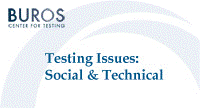Buros-Nebraska Series on Measurement and Testing

Social and Technical Issues in Testing: Implications for Test Construction and Usage
Date of this Version
1984
Document Type
Article
Citation
Published in Social and Technical Issues in Testing: Implications for Test Construction and Usage, edited by Barbara S. Plake (Hillsdale, NJ: Lawrence Erlbaum Associates, 1984).
Abstract
In a talk I gave at the 1979 ETS Invitational Conference, I remarked that, if I were suddenly endowed with the appropriate occult powers, I should choose to eliminate certain words from the psychometric vocabulary. Among them were the words aptitude and achievement (Anastasi, 1980). These terms have led to nearly as much confusion, misinterpretation, and misuse of tests as has the more notorious term intelligence. Having been asked once more to discuss the same general topic in 1982, it occurred to me that I might consider why the myths that surround these terms are so persistent-and persistent they certainly are.
Let us examine specifically the traditional distinction between aptitude and achievement tests. Aptitudes are typically defined more precisely than intelligence, to designate more narrowly limited cognitive domains. Nevertheless, like intelligence, they have traditionally been contrasted with achievement in testing terminology. This contrast dates from the early days of testing, when it was widely assumed that achievement tests measured the effects of learning, whereas intelligence and aptitude tests measured so-called innate capacity, or potentiality, independently of learning. This approach to testing in turn reflected a simplistic conception of the operation of heredity and environment that prevailed in the j 920s and 1930s. The relevant historical background has been thoroughly examined in a recent book by a science historian, Hamilton Cravens, which covers the heredity- environment controversy among American scientists between the two World Wars (Cravens, 1978; see also Anastasi, 1979).
HISTORICAL ANTECEDENTS
Common misconceptions about the relation between aptitude and achievement tests are highlighted by an index introduced in the 1920s and variously named an achievement quotient or an accomplishment quotient. Both terms having the same initials, this index soon came to be known as the AQ. Its origin is generally attributed to Raymond Franzen (1920, 1922). The AQ could be found by dividing the individual’s educational quotient (EQ) by his or her intelligence quotient (IQ). The EQ was the ratio of educational age (EA) to chronological age (CA). The AQ could also be computed more directly by dividing educational age by mental age. The educational age was found by referring the score on an achievement battery to the age norms for that battery. Still another procedure was to use age norms for tests in particular academic subjects, like reading or arithmetic, to find " subject ages" for the individual, and then to average these subject ages to obtain the educational age.
Early textbooks on testing regularly included a discussion of the AQ as a means of evaluating a student's educational performance in relation to that student's intellectual potential- a means of comparing achievement with capacity to learn (Freeman, 1926, 1939; Garrett & Schneck, 1933; Greene, 1941; Lincoln & Workman, 1935; Mursell, 1947). It is interesting to trace the statements about the AQ in texts appearing from the 1920s to the 1940s and early 1950s. Even the earliest discussions called attention to the technical and statistical weaknesses of the AQ as a ratio. The major criticisms fell into two categories: The first category was similar to the now familiar criticisms of the traditional ratio IQ; the second was similar to the equally familiar criticism of grade norms--educational age norms were certainly no better than educational grade norms.


Comments
Copyright © 1984 by Lawrence Erlbaum Associates. Digital edition copyright © 2012 Buros Center for Testing. This book may be downloaded, saved, and printed by an individual for their own use. No part of this book may be re-published, re-posted, or redistributed without written permission of the holder of copyright.